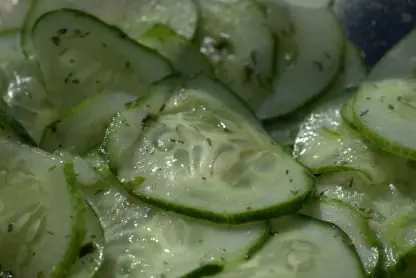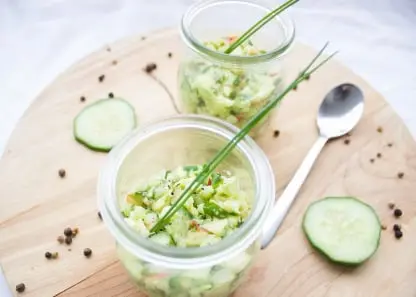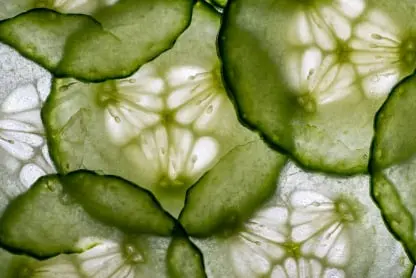Cucumber Food Safety app with AI quality tests:
Cucumber Food Safety app with AI quality tests for complete quality QC management, and manages wash, pack & label, sales and shipping.

Cucumber Food Safetys during production
View app Specifications.
The cucumber plant (Cucumis sativus) belongs to the Cucurbitaceae family, a part of the Cucumis genus. The Cucumis genus contains nearly 40 species, such as the cantaloupe (C. melo), and watermelon (Citrullus vulgaris). The cucumber has many common names including pepino, cetriolo, gherkin, gurke, krastavac, concombre, hunggua, kiukaba, khira, kiukamupa, and kukamba.
Cucumis sativus is a frost-sensitive annual with coarse (large, bold, and rough) leaves and a creeping vine that can reach upwards of six feet in length. The spiraling, hairy vine and tendrils that originate from the axil, allow the plant to readily climb supporting structures. Hairy, three to five-lobed leaves, with a triangular shape that are 10-40 cm in size, are each supported on a petiole and provide a canopy to cover the flowers and fruit. The overall root system is generally shallow (usually penetrates top 30 cm of soil) with lateral roots extending further than the vine; however, a tap root can reach one meter deep.

Daily Cucumber packhouse hygiene checklist
The cucumber plant produces three types of rough, yellow flowers, including a male or staminate flower, a female or pistillate flower, and a hermaphrodite flower with both male and female structures. The pistillate flower can be recognized by its thin pedicles; it also has a large ovary (immature fruit) at its base. The ovary has three chambers and is connected to short, thick stigma lobes. The staminate flower grows in clusters, and each flower is on a slender stem containing three stamens. Hermaphroditic flowers are able to produce round fruits. Regardless of the sex, the flowers are yellow with wrinkled petals.
Cucumber plants are naturally monoecious, meaning there are separate male and female flowers on the same plant. Gynoecious predominately produce female flowers, however, they will produce male flowers under conditions that include longer days, high temperatures, and light-intense days. The seeds of both monoecious and gynoecious maybe mixed for planting in the same area. Pollen is transferred by bees and other insects from the male to female flower. On commercial farms, gynoecious hybrids are more frequently used as they are more productive and develop earlier.

Cucumber Food safety & management
Pick a firm, dark-green cucumber and pop it into your shopping basket. Congratulations! You have just bought yourself a fruit (the cool cuke is a fruit, not a vegetable) full of good health!
Served in a variety of ways, the distinctive crisp, cool vegetable will add extra crunch, whether in a sandwich or in a favorite salad.
Types
Two basic types of cucumbers are common: slicing varieties and pickling varieties. Slicing cucumbers include the typical supermarket variety: long and straight with thin, non-bitter skins and seeds. They are produced for fresh consumption. The skin of younger cucumbers is tender enough to be eaten. As it grows, the skin thickens, and more seeds develop. If left on the vine too long, the flesh may become bitter. Burpless cucumbers are slicing cucumbers that have been bred to produce less of the bitter chemical that releases gas in the stomach.
The pickling varieties are smaller, shorter, and squatter. They have a lighter skin and are bumpy. They are produced to have drier flesh, which allows them to soak up more of the pickling brine for processing into pickles.
Nutrition
The water content of cucumbers is high, which is why the calorie content is so low! One cup of sliced cucumbers has only 13 calories. As one might assume, the protein, carbohydrate, and fat content are also low. Cucumbers provide us with a unique combination of nutrients. At the top of the phytonutrient list for cucumbers are cucurbitacins, lignans, and flavonoids. These three types of phytonutrients found in cucumbers provide us with valuable antioxidant, anti-inflammatory, and anti-cancer benefits. Cucumbers are a good source of vitamin K and the mineral molybdenum.

Cucumber Supplier Food Safety & management
The U.S. Food and Drug Administration (FDA) set out to collect and test cucumbers in 2015 under the agency’s new proactive and preventive approach to deploying its sampling resources with the ultimate goal of keeping contaminated food from reaching consumers.
The approach, detailed in the Background section of this report (page 5), centers on the testing of a large number of samples of targeted foods over a relatively short period, about 18 months, to ensure that enough data are available to inform decisions. This approach may help the agency determine if there are common factors – such as origin, variety or season – associated with pathogen findings.
The FDA issued the cucumbers assignment in November 2015 under its then new sampling model. The agency collected 1,601 samples to test to determine the prevalence of Salmonella spp. and Escherichia coli (E. coli) O157:H7 in the commodity. The agency collected about 76 percent of its samples from imported cucumbers and the rest from domestically produced cucumbers, comparable to their respective U.S. market shares at the start of the assignment. The agency designed its sampling plan such that if contamination of one percent or greater was present in the commodity, the agency would be likely to detect it. The agency monitored the assignment closely to gather lessons learned and to make changes to its sampling procedures if needed to address trends or food safety issues.
The FDA collected cucumbers grown in fields and greenhouses, with all varieties of the commodity eligible to be sampled. The agency did not collect frozen, chopped, sliced, pureed or pickled cucumbers, or those that it knew to be intended for a ‘kill step’ to eliminate pathogens. The agency found the prevalence of Salmonella in the samples collected to be 1.75 percent, based on the test results. The FDA did not detect E. coli O157:H7 (or other pathogenic E. coli) in any samples.